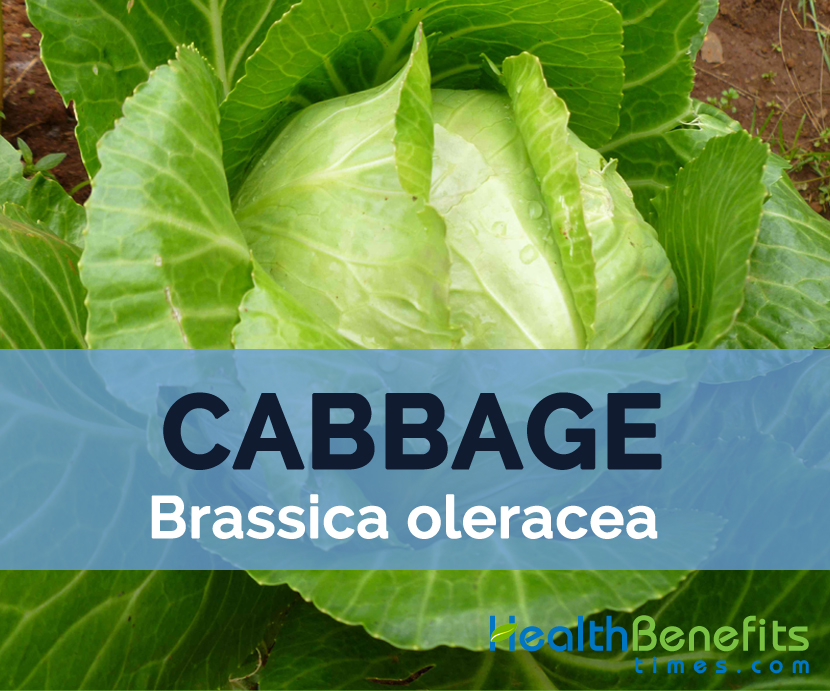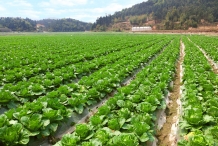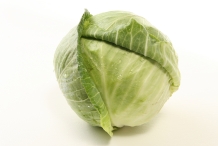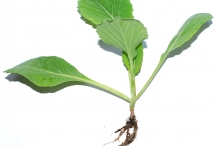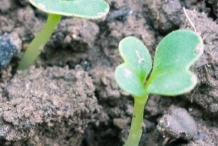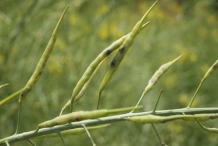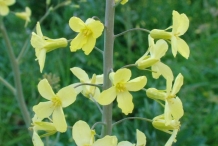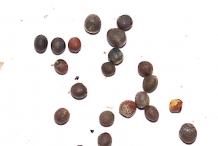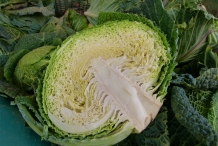| Cabbage Quick Facts | ||
|---|---|---|
| Name: | Cabbage | |
| Scientific Name: | Brassica oleracea | |
| Origin | Southern and Western Europe | |
| Colors | Green, purple and white | |
| Shapes | Flat, round, egg-shaped, oval or conical; 25–100 mm | |
| Flesh colors | Soft, light green or whitish | |
| Calories | 17 Kcal./cup | |
| Major nutrients | Vitamin K (67.92%) Vitamin C (31.22%) Manganese (6.70%) Vitamin B6 (6.46%) Vitamin B9 (5.50%) |
|
| Health benefits | Prevents cancer, Vision health, Enhance brain, Protect bones, Skin health | |
| Proximity | Amount | % DV |
|---|---|---|
| Water | 69.43 g | N/D |
| Energy | 17 Kcal | N/D |
| Energy | 73 kJ | N/D |
| Total dietary Fiber | 1.4 g | 3.68% |
| Carbohydrate | 4.13 g | 3.18% |
| Protein | 0.95 g | 1.90% |
| Total Fat (lipid) | 0.04 g | 0.11% |
| Ash | 0.44 g | N/D |
| Total Sugars | 2.09 g | N/D |
| Glucose (dextrose) | 1.22 g | N/D |
| Fructose | 0.87 g | N/D |
| Minerals | Amount | % DV |
|---|---|---|
| Manganese, Mn | 0.154 mg | 6.70% |
| Calcium, Ca | 36 mg | 3.60% |
| Phosphorus, P | 25 mg | 3.57% |
| Potassium, K | 147 mg | 3.13% |
| Magnesium, Mg | 11 mg | 2.62% |
| Iron, Fe | 0.13 mg | 1.63% |
| Copper, Cu | 0.013 mg | 1.44% |
| Zinc, Zn | 0.15 mg | 1.36% |
| Selenium, Se | 0.4 µg | 0.73% |
| Sodium, Na | 6 mg | 0.40% |
| Fluoride | 0.8 µg | 0.02% |
| Vitamins | Amount | % DV |
|---|---|---|
| Vitamin K (phylloquinone) | 81.5 µg | 67.92% |
| Vitamin C (Ascorbic acid) | 28.1 mg | 31.22% |
| Vitamin B6 (Pyridoxine) | 0.084 mg | 6.46% |
| Vitamin B9 (Folate, Folic acid) | 22 µg | 5.50% |
| Vitamin B1 (Thiamin) | 0.046 mg | 3.83% |
| Choline | 15.2 mg | 2.76% |
| Vitamin B5 (Pantothenic acid) | 0.13 mg | 2.60% |
| Vitamin B2 (Riboflavin) | 0.028 mg | 2.15% |
| Vitamin B3 (Niacin) | 0.186 mg | 1.16% |
| Vitamin E (alpha-tocopherol) | 0.11 mg | 0.73% |
| Beta Carotene | 36 µg | N/D |
| Betaine | 0.2 mg | N/D |
| Lutein + zeaxanthin | 20 µg | N/D |
| Lipids | Amount | % DV |
|---|---|---|
| Fatty acids, total monounsaturated | 0.014 g | N/D |
| Palmitoleic acid 16:1 (hexadecenoic acid) | 0.007 g | N/D |
| Oleic acid 18:1 (octadecenoic acid) | 0.007 g | N/D |
| Fatty acids, total polyunsaturated | 0.017 g | 0.10% |
| Linoleic acid 18:2 (octadecadienoic acid) | 0.007 g | N/D |
| Linolenic acid 18:3 (Octadecatrienoic acid) | 0.01 g | N/D |
| Phytosterols | 8 mg | N/D |
| Amino Acids | Amount | % DV |
|---|---|---|
| Tryptophan | 0.008 g | 1.82% |
| Valine | 0.032 g | 1.52% |
| Threonine | 0.026 g | 1.48% |
| Isoleucine | 0.022 g | 1.32% |
| Histidine | 0.016 g | 1.30% |
| Lysine | 0.032 g | 0.96% |
| Leucine | 0.031 g | 0.84% |
| Tyrosine | 0.014 g | 0.48% |
| Cystine | 0.008 g | 0.48% |
| Methionine | 0.009 g | N/D |
| Phenylalanine | 0.024 g | N/D |
| Arginine | 0.056 g | N/D |
| Alanine | 0.032 g | N/D |
| Aspartic acid | 0.091 g | N/D |
| Glutamic acid | 0.219 g | N/D |
| Glycine | 0.022 g | N/D |
| Proline | 0.036 g | N/D |
| Serine | 0.039 g | N/D |
Health benefits of Cabbage
The studies have shown that the intake of Cabbage helps to reduce the chances of diabetes, obesity and heart disease. It enhances the complexion, increase energy and reduce weight. Cabbage possess huge amounts of Vitamin B6, fiber, manganese, folate, phosphorus, magnesium, iron, potassium and calcium which helps to regulate the blood pressure and heart rate.
- Prevents cancer
Cabbage possess huge amount of antioxidants which helps to eliminate the free radicals from the body and reduce the chances of heart disease and cancer. It is also rich in anti-cancer compounds such as sinigrin, lupeol and sulforaphane that enhances the enzyme activity and forbid the tumor growth that lead to cancer. The study shows that the regular intake of cabbage reduces the breast cancer in women. (1) (2)
- Anti-inflammatory agent
Cabbage possesses glutamine which is known to be an anti-inflammatory agent. The regular intake of Cabbage helps to lower the inflammation, joint pain, irritation, fever, allergies and skin disorders. (3)
- Vision health
Cabbage possess high amount of beta-carotene which helps to prevent the chances of macular degeneration by enhancing eye health and delay the formation of cataracts. Beta-carotene is related to reduce chances of prostate cancer. (4) (5)
- Helps to lose weight
Cabbage is loaded with various minerals, vitamins and nutrients. It possess huge amount of fiber that adds bulk to the bowels. Cabbage is also low in calories. It makes the people feel full for long time. (6)
- Enhance brain
Cabbage possesses anthocyanins and Vitamin K which promote the concentration and mental function. Vitamin K is required for the production of myelin sheath and sphingo lipids around nerves. It prevents the nerve damage and decay. The consumption of Vitamin K enhances the defense against Alzheimer’s disease, neural degeneration and dementia. The antioxidants found in Cabbage reduce the chances of cancer, counteracts diseases, enhance the brain function as well as nervous system. (7)
- Protect bones
Cabbage is good source of minerals such as magnesium, calcium and potassium which are essential to protect bones from the degradation and the health conditions such as general bone weakening and osteoporosis.
- Maintain blood pressure
Cabbage contains potassium which helps to maintain the blood pressure and reduce the chances of stroke as well as heart attack. Potassium assists to open the blood vessels and ease the blood flow by preventing the stress induced flow of blood through constricted veins and arteries.
- Skin health
Cabbage is rich in antioxidant sources such as sulphur, vitamin C and anthocyanins. Antioxidant plays a vital role in the skin health. It eliminates the free radicals which are the cause of skin discoloration, wrinkles, spots and others. The consumption of cabbage provides the young and healthy skin. (8)
- Relieves muscle pain
Lactic acid is released during the cooking of sauerkraut which helps to lower the muscle ache and soreness. This compound is not found in other diets. It relieves the general pain and muscle soreness. (9)
- Detoxify body
Cabbage eliminates toxins, free radicals, uric acid and also purifies the blood which is the cause for gout, rheumatism, arthritis, skin diseases, renal calculi and eczema. The high presence of Vitamin C and Sulphur in the Cabbage provides this detoxifying effect.
https://www.youtube.com/watch?v=FxkMXd4JnaM
How to Eat
- It could be consumed raw or pickled.
- It is also fermented for dishes such as steamed, sauerkraut, stewed, braised and sautéed.
- It could be added to the salads.
- They are boiled, steamed and stir-fried.
- The leaves are used to wrap the foods before baking or braising.
Traditional uses
- The juice which is extracted from red cabbage is useful for bronchitis, chronic coughs and asthma.
- The juice of white cabbage is used to cure warts.
- The bruised leaves of white cabbage are used to treat blisters.
- The juice of the cabbage helps to heal the gastric ulcer.
- Cabbage is used in folk medicine of European to treat acute inflammation.
- The paste made from the raw cabbage, if wrapped around the affected area by placing it in a leaf of cabbage helps to eliminate discomfort. It provides relief from painful engorged breasts in the breastfeeding women.
Cabbage – Brassica oleracea Facts
The cabbage is the powerhouse of minerals and vitamins. It is an oldest member of the family Brassiacaceae. It firstly appeared over 4,000 years ago as a wild leafy plant in Europe. Due to its high nutrient content, Cabbage became a highly favored food.
| Name | Cabbage |
|---|---|
| Scientific Name | Brassica oleracea |
| Native | Southern and Western Europe |
| Common/English Name | Cabbage, White cabbage, Repolyo, Gan lan |
| Name in Other Languages | Chinese: Lan cai, Ye cai Danish: Hovedkål Dutch: Sluitkoolachtigen, Sluitkool Estonian: Peakapsas Finnish: Keräkaali French: Chou cabus, Chou commun Hindi: Band gobhii Italian: Cavolo cappuccio Japanese: Kyabetsu, Kanran Polish: Kapusta warzywna gowiasta Portuguese: Couve de cabeça, Couve de repolho Russian: Kapusta belokachannaia Spanish: Col, Berza común Urdu: Band gobhii |
| Plant Growth Habit | Biennial, herbaceous, dicotyledonous plant |
| Growing Climate | Cool |
| Soil | Well-drained |
| Plant Size | 40–60 cm (16–24 inch) |
| Root | Fibrous and shallow |
| Stem | Glabrous, erect |
| Leaf | Ovate (egg-shaped), thick, alternate, smooth or crinkled |
| Leaves color | Light yellowish green – dark green and dark red |
| Flowering Season | Spring, Late Spring, Early Summer |
| Buds | Gigantic |
| Flower | Yellow |
| Fruit shape & size | Flat, round, egg-shaped, oval or conical; 25–100 mm |
| Fruit weight (Cabbage head) | 0.5-4 kilograms (1-9 lb.) |
| Fruit color | Green, purple and white |
| Flesh color | Soft, light green or whitish |
| Flavor/aroma | Strong pungent flavor |
| Seed | Small, round, brown or black |
| Varieties/Types |
|
| Fruit Season | Spring or Fall |
| Major Nutritions | Vitamin K (phylloquinone) 81.5 µg (67.92%) Vitamin C (Ascorbic acid) 28.1 mg (31.22%) Manganese, Mn 0.154 mg (6.70%) Vitamin B6 (Pyridoxine) 0.084 mg (6.46%) Vitamin B9 (Folate, Folic acid) 22 µg (5.50%) Vitamin B1 (Thiamin) 0.046 mg (3.83%) Total dietary Fiber 1.4 g (3.68%) Calcium, Ca 36 mg (3.60%) Phosphorus, P 25 mg (3.57%) Carbohydrate 4.13 g (3.18%) |
| Health Benefits |
|
| Precautions |
|
| Other Facts |
|


